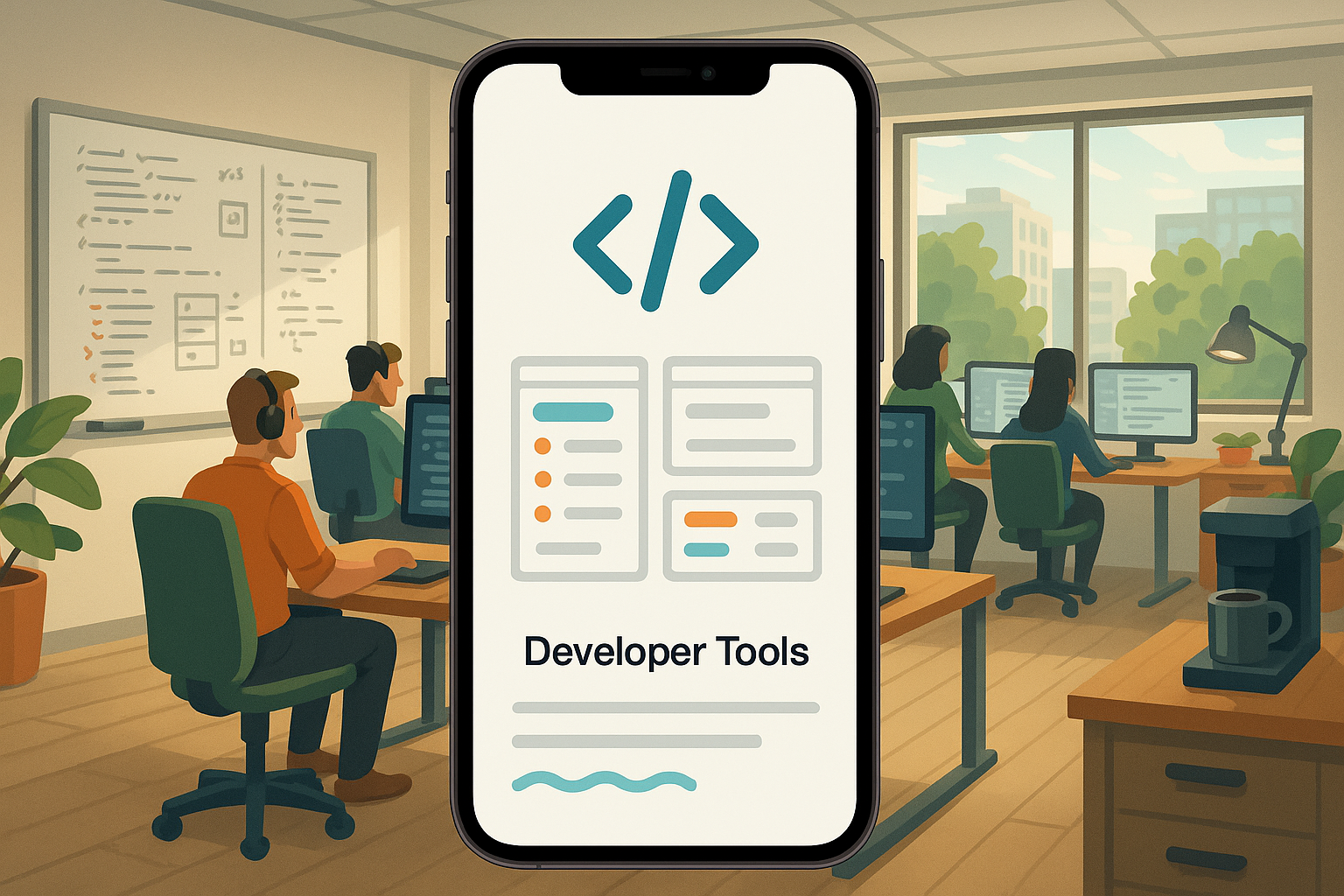Introduction
In the fast-paced world of software creation, developers are the architects of our digital future. To build efficiently and effectively, they rely on a powerful arsenal of developer tools. Creating a new tool for this discerning audience is a monumental task. The market is saturated, the users are experts who demand perfection, and the technical hurdles are immense. A single misstep can lead to a tool that is ignored, a budget that is obliterated, and a project that fails to launch.
This challenge is precisely why a strategic approach is critical. Building a developer tool isn’t just about writing code; it’s about deeply understanding a developer’s workflow, identifying pain points, and engineering a solution that is not just functional but elegant, scalable, and reliable. Many companies attempt this in-house, only to find themselves tangled in unforeseen complexities, resource drains, and quality compromises.
This article will serve as your comprehensive guide to the world of developer tools app development. We will explore what constitutes a developer tool, dissect the significant reasons why building one in-house is so difficult, and categorize the different types of tools available. We will also provide a realistic perspective on development costs and showcase the top companies that have successfully navigated this space.
As a top US AI-powered app development firm, we at MetaCTO have over two decades of experience turning complex ideas into market-ready applications. We understand the unique challenges of building for developers. This guide will not only provide you with crucial information but also illustrate how partnering with an expert team like ours can be the key to transforming your vision for a developer tool into a successful, widely-adopted product.
What is a Developer Tools App?
At its core, a developer tool is any piece of software or service designed to simplify the process of coding and software development. These tools are the foundation upon which all other software is built, acting as force multipliers that enhance a developer’s productivity, streamline complex processes, and ensure higher-quality outcomes. They form an ecosystem that supports every stage of the software development lifecycle, from the initial line of code to deployment and ongoing maintenance.
The scope of what can be considered a developer tool is incredibly broad. According to AWS, developer tools can encompass a wide range of categories, including:
- Programming Languages, Frameworks, and Libraries: These are the fundamental building blocks. Languages like Python or JavaScript, frameworks like React or Django, and libraries like jQuery or Pandas provide pre-written code and structures that save developers from having to reinvent the wheel.
- Platforms: These provide an environment for developers to build and run their applications. Examples include cloud platforms like AWS or application platforms like Heroku.
- APIs (Application Programming Interfaces): APIs allow different software applications to communicate with each other, enabling developers to integrate third-party services and functionality without needing to build it themselves.
- Software Applications and Components: This is a vast category that includes everything from text editors and integrated development environments (IDEs) to more specialized applications for database management or API testing.
- Services: This includes a growing number of cloud-based services that offer functionality on demand, such as authentication services, CI/CD pipelines, and infrastructure as code (IaC) providers.
Ultimately, if a product helps a developer write, build, test, deploy, or manage code more effectively, it can be classified as a developer tool. The goal is always to reduce friction, automate repetitive tasks, and empower developers to focus on solving unique and challenging problems.
Reasons that it is difficult to develop a Developer Tools app in house
Embarking on the journey of creating a developer tool in-house can seem like a logical step, especially for a tech-focused company. However, the path is fraught with challenges that are often underestimated. These hurdles go beyond mere coding and touch upon deep-seated issues in team structure, expertise, and process management.
Lack of Specialization and Focus
One of the most common pitfalls in in-house development is the “jack-of-all-trades” approach. To save on costs, a single specialist is often tasked with handling a multitude of roles: frontend, backend, API solutions, DevOps, and testing. While this may seem efficient on the surface, it eliminates the deep focus required for each individual task. A developer tool must excel in every area—performance, usability, and reliability. When attention is divided, the specifics and workings of individual architectural elements are neglected, leading to a direct reduction in overall quality assurance and a product that feels mediocre across the board.
Communication and Integration Gaps
Even with a larger team, in-house projects often suffer from a disconnect between different components. The separation between frontend and backend teams, without direct and seamless communication channels, can lead to serious delays. A request from one component might wait indefinitely for a response from another, crippling the efficiency of their interaction. This lack of integration creates a disjointed user experience and a fragile architecture that is difficult to scale and maintain.
The Triad of Scalability, Stability, and Reliability
Achieving a perfect balance between scalability, stability, and reliability is the holy grail of software development, and it is seldom achieved in in-house digital products. This failure stems from two primary sources:
- Lack of Competent Personnel: The talent pool is surprisingly shallow. It’s estimated that no more than 10 percent of all IT candidates possess a deep comprehension of complex software development processes and their subsequent maintenance. Finding individuals with the niche skills to build a highly scalable and reliable developer tool is a significant challenge.
- Lack of Awareness: In-house teams are often unaware of the highly specialized software and infrastructure solutions that can optimize their architecture. They may spend months building a component that could have been implemented more effectively using an existing, battle-tested service.
Disjointed Teams and Inefficient Workflows
The work of in-house development team specialists is often very disjointed. A lack of clear coordination leads to poor synchronization between developers, designers, and testers. This siloed approach decreases overall work efficiency, causes rework, and extends timelines. Without a unified process and strong project management, teams waste time waiting on handoffs and resolving conflicts that arise from misaligned efforts.
The Challenge of Design and User Experience
Developers, as users, have a high standard for design. A developer tool’s interface must be intuitive, efficient, and aesthetically pleasing. Creating a memorable and unique design requires a rare blend of creativity and technical skill. The design must not only look good but also be applicable across different products and platforms, preserving the original idea while emphasizing the solution’s advantages. This is a specialized skill that is often absent in generalist in-house teams.
Tool Sprawl and Lack of Unification
Any software project relies on a large number of underlying technologies: programming languages, data stores, infrastructure management tools, and more. In an in-house setting, this can lead to a disorganized mess. Without a clear strategy for unification, teams end up with a confusing patchwork of tools and services. This disorganization creates confusion during practical application and makes the entire system brittle and difficult to manage.
A Blind Spot for Customer Needs
Finally, in-house development teams often build in a vacuum. They can be so focused on the technical implementation that they fail to consider the myriad of moments that make up the customer’s experience. This leads to a lower level of awareness of customer interests and needs. The end result is a product that, while technically functional, is not truly customer-centric. It fails to solve the user’s real-world problems in an intuitive way and ultimately fails to gain traction.
Different types of Developer Tools apps
The landscape of developer tools is vast and varied, with specialized solutions for nearly every aspect of the software development lifecycle. Understanding these categories can help clarify the function and purpose of different tools.
Coding Tools
These are the tools that developers interact with most directly when writing code. They provide the core logic, structure, and shortcuts that accelerate development.
- Compilers and Code Builders: These tools translate human-readable code into machine code that a computer can execute.
- Frameworks and Libraries: As mentioned earlier, these provide reusable code and a structured way to build applications.
- Software Development Kits (SDKs): An SDK is a collection of tools and libraries for a specific platform or programming language. For example, the iOS SDK is required to build apps for Apple devices. AWS provides numerous SDKs for interacting with its services.
Programming Support Tools
These tools support the coding process by providing an organized environment and mechanisms for collaboration and version management.
- Integrated Development Environment (IDE): An IDE is a software application that bundles common developer tools into a single graphical user interface. It typically includes a source code editor, build automation tools, and a debugger.
- Code Versioning Systems: These systems track changes to code over time, allowing multiple developers to collaborate on a project without overwriting each other’s work. Git is the most popular versioning system, and services like AWS CodeCommit provide managed Git repositories.
DevOps Tools
DevOps is a set of practices that combines software development (Dev) and IT operations (Ops). DevOps tools are designed to automate and integrate the processes between these teams.
- Continuous Pipeline Tools: These tools automate the build, test, and deployment phases of the development lifecycle, a practice known as Continuous Integration/Continuous Deployment (CI/CD). AWS provides CI/CD services to facilitate this.
- Infrastructure as Code (IaC) Services: IaC is the practice of managing and provisioning infrastructure through code instead of through manual processes. This allows for more consistent and repeatable environment setups.
Software-Testing Tools
Ensuring software quality is a critical part of development, and a dedicated category of tools exists to facilitate this.
- Profilers and Debuggers: Profilers analyze a program’s performance, while debuggers help developers find and fix errors (bugs) in their code.
- Bug Trackers: These are applications that help teams record, track, and manage reported bugs.
- Security Testers: With cybersecurity being a major concern, specialized tools are used to identify vulnerabilities. These include Static Application Security Testing (SAST) tools, which analyze source code, and Dynamic Application Security Testing (DAST) tools, which test an application in its running state.
Cost estimate for developing a Developer Tools app
Estimating the cost of developing a developer tool is notoriously difficult because there is no one-size-fits-all answer. The final price tag can range from a few thousand dollars for a simple, single-purpose utility to millions for a comprehensive platform like GitLab or Retool. The cost is not a fixed number but a variable dependent on several key factors.
- Complexity and Scope: This is the single biggest driver of cost. Are you building a simple command-line interface (CLI) tool that performs one task, or a full-fledged, multi-user platform with a sophisticated user interface, real-time collaboration features, and extensive third-party integrations? The more features you add—AI-powered code suggestions, advanced analytics, complex workflow automation—the more time and resources will be required.
- Platform Support: Will your tool be a web application, a desktop app for Windows, macOS, and Linux, a browser extension, or an IDE plugin? Supporting multiple platforms adds significant complexity and cost, as each may require a separate codebase or specialized development expertise.
- Team Size and Expertise: The cost is directly tied to the number of people working on the project and their experience level. Building a robust developer tool requires senior engineers with expertise in areas like system architecture, security, performance optimization, and user experience design. A larger, more experienced team will have a higher burn rate but can often deliver a higher-quality product faster.
- Third-Party Integrations and APIs: A modern developer tool rarely stands alone. It needs to integrate with other services like GitHub, Slack, Jira, and various cloud providers. Each integration adds development and maintenance overhead. If you are building a tool that provides its own API for others to use, you must also account for the cost of designing, documenting, and supporting that API.
Given these variables, providing a specific dollar figure without a detailed plan is impossible. The first step in understanding the potential cost is to develop a clear product strategy and roadmap. This is where a service like our Fractional CTO engagement can be invaluable. We work with you to dive deep into your goals, define the core features for a Minimum Viable Product (MVP), and create a detailed plan that allows for a much more accurate cost and timeline projection.
Top Developer Tools app development companies
The developer tools market is home to some of the most innovative and successful companies in the tech industry. While many of these are product companies that build and sell their own tools, understanding their success provides a blueprint for what it takes to create a great product. For businesses looking to build their own custom developer tool or integrate one into their existing applications, partnering with an expert development agency is often the most effective path.
1. MetaCTO
At MetaCTO, we specialize in building complex, AI-enabled mobile and web applications. We position ourselves as the premier partner for businesses that need to build a custom developer tool or navigate the complexities of integrating third-party developer services into their products. With over 20 years of experience, we have a proven track record of launching successful projects and helping our clients secure over $40 million in fundraising.
Our process is designed to mitigate the risks of in-house development. We handle every step, from validating your idea with a Rapid MVP Development service to building, launching, and scaling the final product. We bring the specialized expertise in architecture, security, and user experience that is often lacking in in-house teams.
Overcoming Integration Challenges
A common and significant challenge, particularly in mobile app development, is the integration of third-party APIs and SDKs. The Android development process, for example, is known for complexities that can arise when trying to make different services work together seamlessly. This isn’t just a technical problem; it’s a strategic one. A poorly integrated tool can lead to app instability, poor performance, and a frustrating user experience.
This is where hiring a dedicated development agency like MetaCTO provides a distinct advantage. Our team has deep experience integrating a wide array of developer tools, from payment gateways and analytics platforms to AI models and real-time communication services. We understand the nuances of each platform and can anticipate potential conflicts and performance bottlenecks. We ensure that every integration is robust, secure, and enhances the overall functionality of your app, rather than compromising it. By entrusting this complexity to us, you free up your team to focus on your core business goals.
Other Leading Developer Tool Companies
To understand the landscape, it’s helpful to look at the established leaders who have built powerful platforms for developers. These companies, many of which were backed by the prestigious Y Combinator accelerator, demonstrate the high bar for success in this space.
| Company | Description | Key Products / Features | Notable Customers |
|---|---|---|---|
| GitLab | The first single application for the entire DevOps lifecycle. It enables Concurrent DevOps for radical new levels of efficiency. | Source code management, CI/CD, monitoring, security scanning, project management in a single platform. | Ticketmaster, Jaguar Land Rover, NASDAQ, Comcast |
| Amplitude | A digital analytics platform that helps businesses understand user behavior. | Product analytics, experiment, CDP, and session replay to see what users love and where they get stuck. | Doordash, Coinbase, Atlassian, Canva |
| Algolia | A leading Search & Discovery API for websites and mobile apps. | Hosted platform that provides fast, relevant, and scalable search experiences with developer-friendly APIs. | Under Armour, Twitch, Stripe, Medium |
| Retool | A platform that provides a fast way to build internal tools. | A drag-and-drop interface to quickly build UIs on top of databases and APIs for admin panels, dashboards, and more. | Amazon, DoorDash, NBC, Brex |
| Mux | An API-first video platform designed to make world-class video streaming and analytics possible for every development team. | Mux Video (API for streaming) and Mux Data (Quality of Experience analytics). | Robinhood, PBS, ViacomCBS, Equinox |
| Apollo GraphQL | The leader in open source and commercial GraphQL technologies. | A graph platform to unify GraphQL efforts, collaborate on graph development, and safely iterate on graphs. | Walmart, Expedia, Glassdoor, PayPal |
| Replit | A collaborative browser-based development environment (IDE). | An online platform to learn, create, and deploy code in over 50 languages, with a community of 20m+ developers. | Used by millions of individual developers and for educational purposes. |
| HackerRank | A developer skills company that helps businesses attract, evaluate, and hire technical talent. | A platform for coding challenges, technical interviews, and skills assessments. | Over 25% of the Fortune 100 |
Conclusion
The journey of creating a developer tool is both rewarding and incredibly challenging. These tools are the bedrock of the digital world, empowering developers to build the software that shapes our lives. As we’ve explored, success requires more than just a great idea; it demands deep technical expertise, a laser focus on user experience, and a robust strategy to overcome the significant hurdles of in-house development. From the risk of a generalized, unfocused team to the complexities of achieving scalability and the difficulty of integrating disparate systems, the potential pitfalls are numerous.
Integrating these powerful tools into your own products, especially mobile apps, presents its own set of challenges. The complexity of third-party API and SDK integration can easily derail a project, leading to performance issues and a compromised user experience. This is not a task to be taken lightly.
By understanding the different categories of tools, the challenges involved in their creation, and the landscape of successful companies, you are better equipped to make strategic decisions. The clearest path to success often involves partnership. By leveraging the experience of a specialized firm, you can avoid the common mistakes of in-house development and ensure your product is built on a solid foundation.
If you are ready to build a powerful new developer tool or need to seamlessly integrate one into your application, we are here to help. Talk with a Developer Tools expert at MetaCTO to build a product that not only meets the high standards of the developer community but also drives your business forward.






